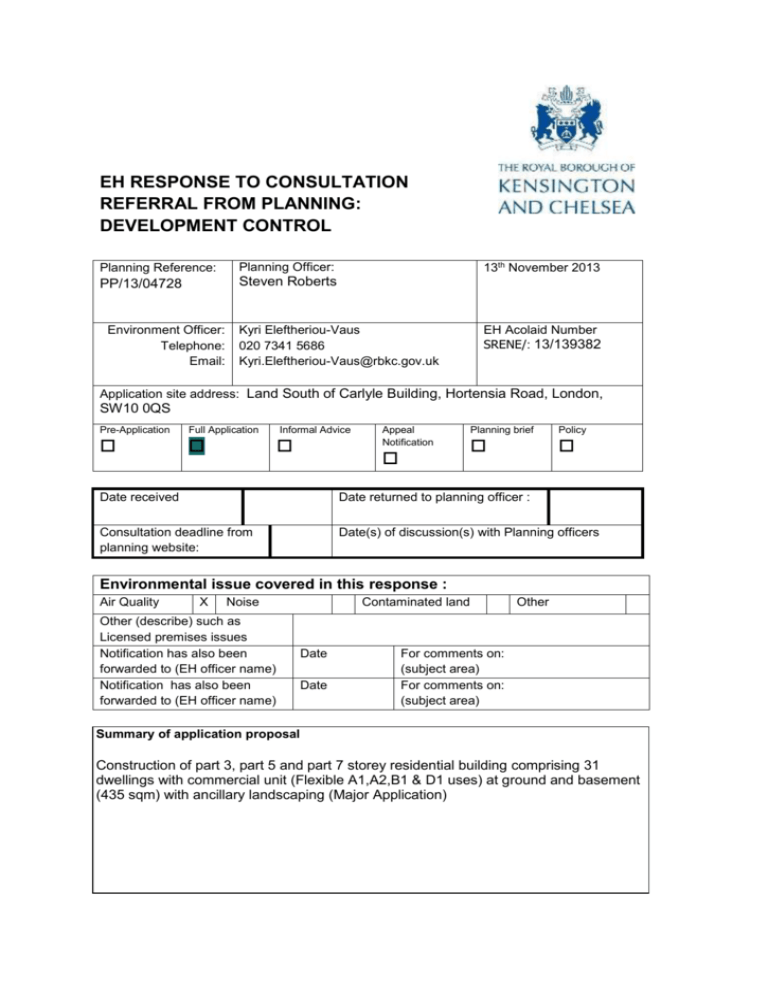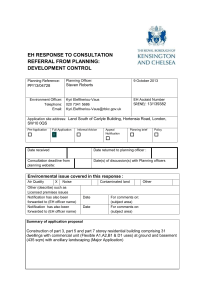Consultee Responses
advertisement

EH RESPONSE TO CONSULTATION REFERRAL FROM PLANNING: DEVELOPMENT CONTROL Planning Reference: Planning Officer: PP/13/04728 Steven Roberts Environment Officer: Telephone: Email: 13th November 2013 Kyri Eleftheriou-Vaus 020 7341 5686 Kyri.Eleftheriou-Vaus@rbkc.gov.uk EH Acolaid Number SRENE/: 13/139382 Application site address: Land South of Carlyle Building, Hortensia Road, London, SW10 0QS Pre-Application Full Application Informal Advice Appeal Notification Planning brief Policy Date received Date returned to planning officer : Consultation deadline from planning website: Date(s) of discussion(s) with Planning officers Environmental issue covered in this response : Air Quality X Noise Other (describe) such as Licensed premises issues Notification has also been forwarded to (EH officer name) Notification has also been forwarded to (EH officer name) Contaminated land Date Date Other For comments on: (subject area) For comments on: (subject area) Summary of application proposal Construction of part 3, part 5 and part 7 storey residential building comprising 31 dwellings with commercial unit (Flexible A1,A2,B1 & D1 uses) at ground and basement (435 sqm) with ancillary landscaping (Major Application) Comments A revised air quality assessment has been provided for the proposed development, comprising a basement housing plant space and commercial space (135 m2 GIA) Ground floor retail unit for A1/A2/B1/D1 unit of 256 m2 GIA; and 31 residential units arranged over six floors. The site is located on the corner of Hortensia Road and King’s Road and consists of existing hard standing with no buildings currently on the land. Therefore the new development should seek to reduce emissions as currently there are none associated with the site. Energy Statement It is proposed that the development will include a centralised energy centre to provide heating and hot water to all residential units. The original proposal was for the installation of a 10 kWe (17kWth) combined heat and power (CHP) unit to provide base load heating and electricity, (supplemented by 3 x 250 kW low NOx boilers to provide additional heating and hot water). In addition approximately 25m² of PV panels which will reduce CO2 emissions by approximately 6%. AQ assessment of Boiler /Energy emissions The NOx emissions of the initially proposed boiler and CHP micro turbine provided in the air quality report was given as 39.7 mg/kWh (0% Oxygen) for the low NOx Boilers and 45.5 mg/kWh (0% O2) for the Micro Turbine CHP. A different model for the CHP plant is now being proposed and the NOx emissions are expected (as given by Ener-g, the CHP manufacturer) as 499 mg/Nm3 (0% O2), at full load increasing to 3484 mg/Nm3 (75%) and 2233 mg/Nm3 (50%) at partial loads. A catalyst is proposed to reduce emissions to 46mg/Nm3 or 40 mg/kWh (0% O2) based on the full load emissions). The calculations (using the EPUK CHP tool) in Annex A and B are based on a concentration of 236 mg/m3 and 22 mg/m3 at reference conditions (i.e. 11% O2, 101Kpa 273K) without catalyst; this may not be representative of the range of operational conditions of the CHP plant. At this level of emissions there is an increase of 2.4 µg/m3 at the nearest receptor to Hortensia Road without the catalyst. The predicted reduction with the use of a catalyst is expected to result in an increase of approx 0.20-0.23 µg/m3. However at partial loads the NOx emissions for the plant selected are higher as the operational conditions will vary considerably the unit will not be able to achieve the reductions stated and the impact will be greater. Therefore the plant should not be operated on partial loads and the effectiveness of the catalyst needs to be demonstrated before installation. Ideally rather than relying on abatement equipment more should be done to improve the energy efficiency of the building as a whole as this will reduce all emissions i.e. CO2, NO2 and PM10. However the option to use CHP plant whilst this is deemed to reduce emissions this is based on a partial assessment based on the expected reduction in carbon due to electricity replacement from the grid. These calculations take no account of the reduced energy efficiency for delivering the base load heating. The use of more non combustion renewable technology such as PV panels would again reduce all emissions locally. If the approach recommended above is not pursued then as a minimum we require that the AQ assessments is updated to include the total emissions without the catalyst (which would be 3650*(130*499) = 236775500 mg/yr (236.8kg/yr). We will also require confirmation from the manufacturer that the specific unit can be supplied with a catalyst and evidence that that it will reduce the emissions to 40 mg/kWh (0% O2) at all operational conditions. Conclusions More of the energy provision should be made through low polluting options such as PV panels rather than CHP and total demand reduced through improved energy efficiency. In addition the AQ report should be amended to include the total emissions for the boiler and CHP plant without catalyst and the effectiveness of the catalyst. It should also provide information on the likely impact on the NOx concentrations and emissions if the CHP is operated at partial loads. Confirmation will be required from the manufacturer that this specific unit can be supplied with a catalyst (at a viable cost) and evidence that that it will reduce the emissions as described. Therefore the following conditions should be set to ensure that the emissions are no higher than those stated in the assessment. To mitigate the impacts of the construction I recommend a condition for a Construction Environmental Management Plan to be prepared. Requested condition(s) Combustion plant emissions 1 Prior to installation of the boilers and CHP plant, certificates should be provided to show indicative emissions of the combustion plant (the emission factor should meet a dry NOx level of 40mg/kWh at 0% O2). Where this is to be achieved by abatement technology, evidence of the reductions to be achieved at varying operational conditions must be provided. 2 Prior to the occupation of the building the CHP plant must be tested at full and partial loads for its NOx emissions by an accredited laboratory. The report must be submitted for approval and should not exceed emissions of dry NOx of 40mg/kWh (at 0% O2) Reason: To comply with the requirements of the NPPF, the Policies 7.14 a and c of the London Plan and Policy CE5 of the Core Strategy Construction No development shall commence until a risk assessment and the appropriate mitigation measures to minimise dust and emissions are incorporated into the site specific Construction Management Plan based on the Mayor’s Best Practice Guidance (The control of dust and emissions from construction and demolition) or the London Plan control of emissions from construction and demolition SPG. This should include an inventory and timetable of dust generating activities, emission control methods and where appropriate air quality monitoring). This must be submitted to and approved in writing by the Local Planning Authority. Reason: To comply with the requirements of the NPPF, Policy 7.14 b of the London Plan, and Policy CE5 of the Core Strategy S.106 opportunities Officer(s) initials KEV Times spent (to nearest half hour)










